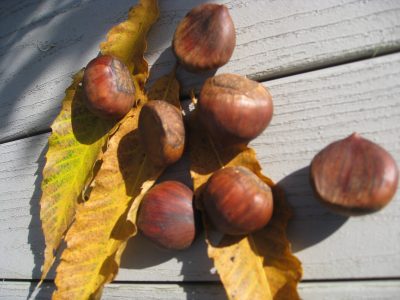By Dawn Pettinelli, UConn Home & Garden Education Center

With Thanksgiving approaching, many of us will be sitting down to hearty feasts with family and friends. Time-tested recipes on worn index cards or heavily thumbed cookbooks are combed through/uncovered. Many of us gardeners pick a few new plants for our gardens each year, so why not try a new plant on the dinner table? Chestnuts were reputedly served at the first Thanksgiving and thanks to dedicated breeding programs may be available locally today.
It’s hard to imagine that a little over 125 years ago there were probably 4 billion American chestnuts (Castanea dentata) spread out from southern Maine to northern Georgia. They were an important food source for both indigenous people as well as wildlife. Early European settlers found their rot resistant wood useful for many building purposes.
Unfortunately, a disease (Cryphonectria parasitica), known as chestnut blight, was unintentionally introduced in 1876 on imported Japanese chestnuts (C. crenata). These were sold via mail order throughout the eastern U.S., and our native American chestnuts soon became infected. This fungus spreads by windblown spores. Signs of infection include a reddish-orange ‘rash’ on the affected bark and as it reproduces, an orangey substance oozes from pores in the bark. Cankers form and eventually the plant can no longer internally transport water and nutrients. Chestnut blight kills the parent tree but not the roots so even to this day, you are able to find sprouts growing from chestnut roots. As the sprouts develop, they too will be killed back by the blight so while the tree is kept alive, American chestnuts are considered functionally extinct, but all is not lost.
Fortunately, both researchers and chestnut lovers have been working pretty much for the past 100 years on developing varieties resistant to chestnut blight. Breeding work has been done in many locations but the Connecticut Agricultural Experiment Station began their program in the early 1900s and it is the only program that has continued uninterrupted to this day. Presently this CAES program is led by Forest Pathologist and Ecologist, Dr. Susanna Kerio.
Various chestnut species including American, Chinese Japanese and European have been crossed, backcrossed, planted, evaluated, culled and selected by researchers and enthusiasts all over the eastern U.S. As one can imagine, it takes more time to evaluate a tree’s characteristics than say, an annual plant like a tomato.
Organizations like The American Chestnut Foundation started in 1982 have been championing the search. According to Deni Ranguelova, the New England Regional Science Coordinator, the goal is to develop blight resistant chestnuts and restore this magnificent tree to its native range. Members of this organization have the opportunity to obtain straight species or hybrid seed to try their hand at growing chestnuts and add observations to the chestnut knowledge base.
Why all this work on chestnuts? Well for one, they are deliciously mild and sweet. They are low in calories and high in fiber. Chestnuts are a good source of potassium and other nutrients. Eat them freshly roasted (just like in the song!), in holiday stuffings, soups, in main dishes and glazed. To cook them, they do need to be scored whether oven roasted, boiled, steamed or microwaved to keep them from bursting. Lots of instructions, recipes and videos can be found online.
Second, plants are productive. In fact, it was estimated that before their demise that a mature American chestnut may be able to produce 6000 nuts! They can serve as a food source to both people and wildlife as researchers and enthusiasts create blight resistant strains to plant in our natural areas or in commercial orchards.
Aside from being a member of The American Chestnut Foundation and obtaining seed, one can order chestnut seedlings from several online nurseries. Keep in mind that chestnuts do best in a sunny area with well-drained soil. Root rots can occur in poorly drained areas. Plants are being bred to be straight and tall for timber, or shorter and wider for nut production. Make sure you have enough space for a mature chestnut tree, or most likely 2 trees as chestnuts need another plant for cross pollination.
Even if a chestnut tree is not in your future, do try some chestnut dishes at your Thanksgiving table. They may start a new tradition.
The UConn Home & Garden Education Center supports UConn Extension’s mission by providing answers you can trust with research-based information and resources. For gardening questions, contact us toll-free at (877) 486-6271, visit our website at homegarden.cahnr.uconn.edu, or reach out to your local UConn Extension center at extension.uconn.edu/locations.
This article was published in the Hartford Courant November 15, 2025